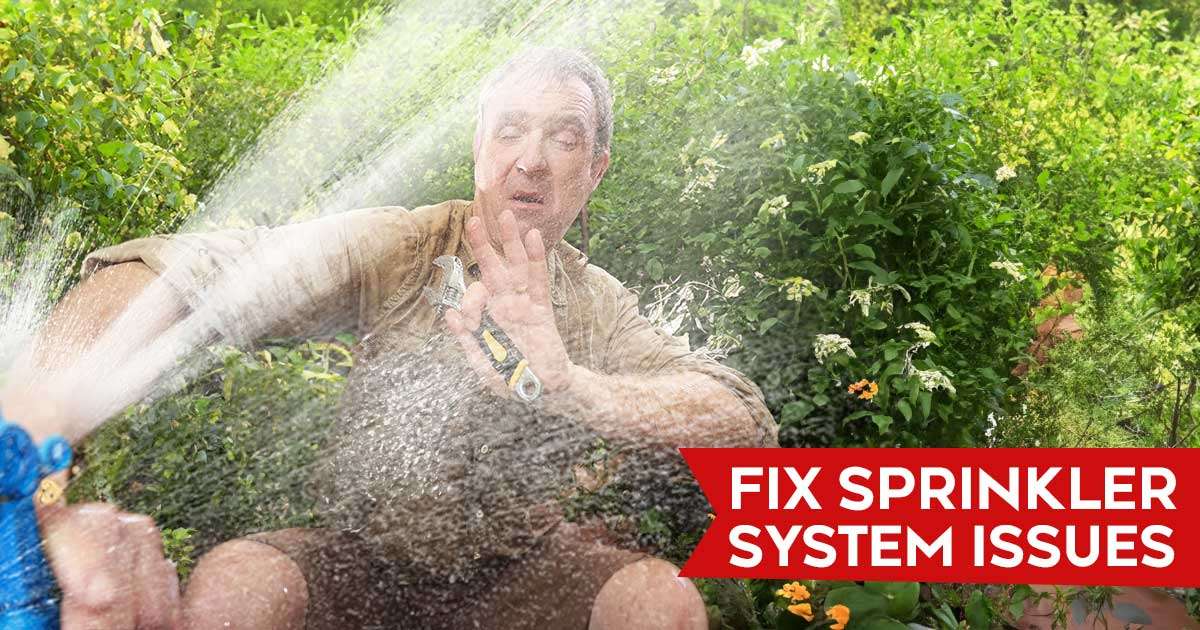How to Fix Sprinkler System Issues with Ease?

Are you having trouble with your lawn sprinkler system? Don’t panic! Many sprinkler system issues can be easily fixed without calling in expensive professionals. You can quickly get your sprinklers working again by following a few easy steps. Learn how to fix sprinkler systems by knowing the most common problems and their solutions.
What are the most common sprinkler system problems?
Before you can fix your sprinkler system, you need to identify the problem. Here are some common issues and how to diagnose them:
- Low Water Pressure: If your sprinklers are not spraying water as they should, the issue might be low water pressure. Check for clogged filters or debris in the sprinkler heads, and ensure that the main water valve is fully open.
- Uneven Watering: The sprinkler heads may be broken if some parts of your yard are getting too much water and others are not. Inspect the heads for clogs, damage, or misalignment.
- Leaking Sprinkler Heads: Leaks can waste water and prevent your sprinklers from effectively watering your lawn. Check the sprinkler heads for damage or cracks, and repair any that are broken.
- Broken Pipes: If you have a broken pipe, you might notice water pooling in certain areas of your lawn. A shovel is used to dig carefully around the suspected area, and the pipe is repaired using a PVC pipe cutter and PVC pipe glue.
- Faulty Valves: If certain zones of your sprinkler system are not working, the issue might be with the valves. Inspect the valves for leaks or damage, and replace any faulty valves.
How to fix low water pressure in a sprinkler system?
Some parts of your lawn may get dry if your watering system doesn’t have enough blood flow. Here’s a simple guide to help you fix it:
- Check the Main Water Supply: Make sure the main water valve to your sprinkler system is fully open.
- Look for Leaks: Walk along the sprinkler lines and check for water pooling or wet spots. Fix any leaks you find.
- Clean Sprinkler Heads: Clogged sprinkler heads can reduce water pressure. Before you clean them, turn off the water. Then, unscrew the sprinkler head and use a small wire to remove any debris from the nozzle and filter screen. After getting rid of the trash, put the sprinkler head back together and turn on the water again.
- Check the Backflow Preventer: A faulty backflow preventer can reduce water pressure. Check it for damage or leaks, and if it’s broken, repair it.
- Inspect the Pressure Regulator: If your system has a pressure regulator, make sure it is set correctly. Adjust or replace it if necessary.
- Check for Clogged or Damaged Pipes: Clogs or damage in the pipes can reduce water flow. To fix this, first, turn off the water supply. Then, inspect the pipes for any damage or clogs. If you find clogs, use a plumber’s snake to clear them. For any damaged pipes, replace them using slip-fix repair couplings.
- Test Water Pressure at the Source: Check the pressure at the main source with a water pressure gauge. The pressure should be between 40 and 60 psi. Get in touch with your water company if it’s low.
- Adjust Sprinkler Zones: If low water pressure affects only one zone, try reducing the number of sprinkler heads in that zone. You can also adjust the watering schedule to run fewer zones at the same time.
- Upgrade Your System: Older systems might not handle modern water pressure needs. Consider upgrading your system or adding a booster pump.
- Get Professional Help: If these steps don’t fix your low water pressure, you should call a plumber. A licensed sprinkler technician can find and fix more complex problems.
If your sprinkler system has low water flow, these steps can help you fix it. This will make sure that your lawn gets the even watering it needs.
How to fix a leaking sprinkler system?
Leaking sprinkler systems are a common issue that can lead to water waste and uneven watering. Here’s a simple guide to fixing them:
- Locate the Leak: Run your sprinkler system and watch for areas where water is pooling or spraying irregularly. To find the leak’s source, dig around shower heads or follow the pipes.
- Fix the Leak: To fix a pipe leak, cut out the broken part and slip-fix repair couplings, putting a new piece in its place. For sprinkler head leaks, tighten the head or replace washers and seals.
- Test and Adjust: After the repair, run your sprinklers again to ensure the leak is fixed. Adjust any sprinkler heads that were moved during repairs.
How to unclog sprinkler heads?
Sprinkler heads that are clogged can make it hard for water to get to all the plants. Here’s how to clear them:
- Identify Clogged Heads: Look for heads that aren’t spraying properly or are only trickling water. The water stream may be distorted.
- Clean the Heads: Turn off the water supply and unscrew the head. Use a paper clip or sprinkler head cleaning tool to remove debris from the nozzle and filter screen. Replace any worn parts.
- Flush the System: Once heads are reassembled, turn the water back on to flush out any remaining debris.
How to fix a broken sprinkler pipe?
Broken underground pipes can be more challenging, but are manageable for DIYers:
- Locate the Break: Run your system and look/listen for areas where no water is surfacing, indicating a buried broken pipe.
- Dig and Repair: Dig down to expose the broken pipe section, taking care not to damage other pipes. Replace the damaged portion using slip-fix couplings or pipe sealant.
- Test and Backfill: Turn the water back on and look for any more leaks. If all is well, backfill the hole with soil and make any necessary lawn sprinkler repairs.
The cost of replacing or repairing broken sprinkler pipes yourself is typically $50 to $850 for most repairs.
How to fix faulty sprinkler valves?
There is a valve that controls each zone of your sprinkler system. If one sticks or fails, it will need repair or replacement.
- Find the Faulty Valve: Turn on each zone and check that the corresponding valve is opening and allowing water flow. The faulty one won’t activate.
- Remove and Replace/Repair: Most valves can be easily removed and swapped out. Some smaller issues with sticking valves may be fixable by cleaning and lubricating the valve components.
The cost of sprinkler valve replacement can range from $90-$150 or more, depending on the valve type and size.
Adjusting for Better Coverage
If dry areas of your lawn persist even after other repairs, you may need to adjust or fix your sprinkler head positioning and spray patterns.
- Check Head Positioning: Ensure heads are not tilted and are positioned to avoid obstructions like walls or landscape features.
- Adjust Spray Arc: Most spray heads allow you to adjust the spray arc by turning an adjustment screw. Increase the arc on heads that aren’t reaching far enough.
- Consider New Heads: For large, persistent dry zones, you may need to add additional sprinkler heads or switch to a model with better coverage.
Successfully Fix Your Broken Sprinkler System
Fixing a sprinkler system can be straightforward if you follow the right steps. Start by checking the main water supply, looking for leaks, and cleaning the sprinkler heads. Inspect the backflow preventer and pressure regulator, and clear any clogs or replace damaged pipes. Adjust sprinkler zones and consider upgrading your system if necessary. You can fix these problems to get the water flow back to normal and make sure your lawn stays healthy and well-watered. If problems persist,seek professional help to diagnose and fix complex issues.

